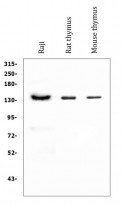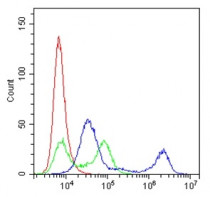ARG41732
anti-CD22 antibody
anti-CD22 antibody for Flow cytometry,IHC-Formalin-fixed paraffin-embedded sections,Western blot and Human,Mouse,Rat
Cancer antibody; Developmental Biology antibody; Immune System antibody; Immature B Cell Marker antibody
Overview
| Product Description | Rabbit Polyclonal antibody recognizes CD22 |
|---|---|
| Tested Reactivity | Hu, Ms, Rat |
| Tested Application | FACS, IHC-P, WB |
| Host | Rabbit |
| Clonality | Polyclonal |
| Isotype | IgG |
| Target Name | CD22 |
| Antigen Species | Human |
| Immunogen | Synthetic peptide corresponding to aa. 696-724 of Human CD22. (LAILILAICGLKLQRRWKRTQSQQGLQEN) |
| Conjugation | Un-conjugated |
| Alternate Names | B-lymphocyte cell adhesion molecule; B-cell receptor CD22; T-cell surface antigen Leu-14; BL-CAM; SIGLEC-2; Sialic acid-binding Ig-like lectin 2; Siglec-2; CD antigen CD22; SIGLEC2 |
Application Instructions
| Application Suggestion |
|
||||||||
|---|---|---|---|---|---|---|---|---|---|
| Application Note | * The dilutions indicate recommended starting dilutions and the optimal dilutions or concentrations should be determined by the scientist. | ||||||||
| Observed Size | ~ 135 kDa |
Properties
| Form | Liquid |
|---|---|
| Purification | Affinity purification with immunogen. |
| Buffer | 0.2% Na2HPO4, 0.9% NaCl, 0.05% Sodium azide and 5% BSA. |
| Preservative | 0.05% Sodium azide |
| Stabilizer | 5% BSA |
| Concentration | 0.5 mg/ml |
| Storage Instruction | For continuous use, store undiluted antibody at 2-8°C for up to a week. For long-term storage, aliquot and store at -20°C or below. Storage in frost free freezers is not recommended. Avoid repeated freeze/thaw cycles. Suggest spin the vial prior to opening. The antibody solution should be gently mixed before use. |
| Note | For laboratory research only, not for drug, diagnostic or other use. |
Bioinformation
| Database Links | |
|---|---|
| Gene Symbol | CD22 |
| Gene Full Name | CD22 molecule |
| Function | Mediates B-cell B-cell interactions. May be involved in the localization of B-cells in lymphoid tissues. Binds sialylated glycoproteins; one of which is CD45. Preferentially binds to alpha-2,6-linked sialic acid. The sialic acid recognition site can be masked by cis interactions with sialic acids on the same cell surface. Upon ligand induced tyrosine phosphorylation in the immune response seems to be involved in regulation of B-cell antigen receptor signaling. Plays a role in positive regulation through interaction with Src family tyrosine kinases and may also act as an inhibitory receptor by recruiting cytoplasmic phosphatases via their SH2 domains that block signal transduction through dephosphorylation of signaling molecules. [UniProt] |
| Cellular Localization | Cell membrane; Single-pass type I membrane protein. [UniProt] |
| Research Area | Cancer antibody; Developmental Biology antibody; Immune System antibody; Immature B Cell Marker antibody |
| Calculated MW | 95 kDa |
| PTM | Phosphorylation of Tyr-762, Tyr-807 and Tyr-822 are involved in binding to SYK, GRB2 and SYK, respectively. Phosphorylation of Tyr-842 is involved in binding to SYK, PLCG2 and PIK3R1/PIK3R2. Phosphorylated on tyrosine residues by LYN. [UniProt] |
Images (3) Click the Picture to Zoom In
-
ARG41732 anti-CD22 antibody IHC-P image
Immunohistochemistry: Paraffin-embedded Human tonsil tissue stained with ARG41732 anti-CD22 antibody.
-
ARG41732 anti-CD22 antibody WB image
Western blot: 50 µg of samples under reducing conditions. Raji, Rat thymus and Mouse thymus lysates stained with ARG41732 anti-CD22 antibody at 0.5 µg/ml dilution, overnight at 4°C.
-
ARG41732 anti-CD22 antibody FACS image
Flow Cytometry: Raji cells were blocked with 10% normal goat serum and then stained with ARG41732 anti-CD22 antibody (blue) at 1 µg/10^6 cells for 30 min at 20°C, followed by incubation with DyLight®488 labelled secondary antibody. Isotype control antibody (green) was Rabbit IgG (1 µg/10^6 cells) used under the same conditions. Unlabelled sample (red) was also used as a control.








